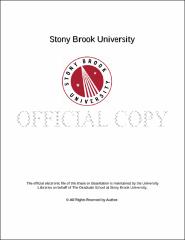| dc.identifier.uri | http://hdl.handle.net/11401/76172 | |
| dc.description.sponsorship | This work is sponsored by the Stony Brook University Graduate School in compliance with the requirements for completion of degree. | en_US |
| dc.format | Monograph | |
| dc.format.medium | Electronic Resource | en_US |
| dc.language.iso | en_US | |
| dc.publisher | The Graduate School, Stony Brook University: Stony Brook, NY. | |
| dc.type | Dissertation | |
| dcterms.abstract | Canalization is the ability of an organism's phenotype to remain stable under a perturbation in their genotype or the environment. It has been noted that there is no canalization or canalization is to a much smaller degree in mutants than in wild type. Waddington's idea was to understand canalization through studying gene interactions. We investigate the mechanisms of canalization of gap gene patterns in </italic>D.melanogaster</italic> through dynamical analysis of the gene circuit. To carry out this investigation we construct a dynamical model of the evolution of the concentration of protein products of the gap genes in time. Our model, which is fitted to both wild type and </italic>Kr<super>-<super></italic> data, correctly captures the wild type averaged data and the lowered gap gene expression in </italic>Kr<super>-<super></italic>. Through a dynamical analysis on a simplified version of this model, we investigate pattern formation in both wild type and </italic>Kr<super>-<super></italic>. The analysis is concentrated on the gap genes </italic>hb</italic>, </italic>Kr</italic>, </italic>gt</italic> and </italic>kni</italic> with outside input from maternal genes </italic>bcd</italic> and </italic>Cad</italic>. Canalization manifests itself in this model by producing a lower variance, in wild type, of posterior </italic>gt</italic> domain, in comparison to Bcd. </italic>Kr<super>-<super></italic> mutants do not canalize Bcd perturbation. We find the geometric structure that ensures the canalization in wild type. This structure is an unstable manifold that patterns the posterior of the wild type embryos while remaining invariant with respect to changes in Bcd. By continuously changing one parameter in our model (maximum synthesis rate of </italic>Kr</italic>), we can smoothly turn down the function of </italic>Kr</italic> in such a way as to model an allelic series running from homozygous wild type levels to heterozygous, and then to hypomorphic and finally to functional null. We discovered that that there is an abrupt onset of the mutant phenotype and loss of canalization triggered by the loss of the canalizing unstable manifold. | |
| dcterms.available | 2017-09-20T16:42:34Z | |
| dcterms.contributor | Green, David | en_US |
| dcterms.contributor | Reinitz, John | en_US |
| dcterms.contributor | Deng, Yuefan | en_US |
| dcterms.contributor | Martens, Marco. | en_US |
| dcterms.creator | Panok, Lena | |
| dcterms.dateAccepted | 2017-09-20T16:42:34Z | |
| dcterms.dateSubmitted | 2017-09-20T16:42:34Z | |
| dcterms.description | Department of Applied Mathematics and Statistics. | en_US |
| dcterms.extent | 135 pg. | en_US |
| dcterms.format | Monograph | |
| dcterms.format | Application/PDF | en_US |
| dcterms.identifier | http://hdl.handle.net/11401/76172 | |
| dcterms.issued | 2013-12-01 | |
| dcterms.language | en_US | |
| dcterms.provenance | Made available in DSpace on 2017-09-20T16:42:34Z (GMT). No. of bitstreams: 1
Panok_grad.sunysb_0771E_11512.pdf: 9310488 bytes, checksum: 338ed028120d4286b532d22c96407c85 (MD5)
Previous issue date: 1 | en |
| dcterms.publisher | The Graduate School, Stony Brook University: Stony Brook, NY. | |
| dcterms.subject | canalization, dynamical analysis, pattern formation | |
| dcterms.subject | Applied mathematics | |
| dcterms.title | The Dynamical Basis of the Decanalization of Gene Expression in Kr uppel Mutant Embryos | |
| dcterms.type | Dissertation | |

